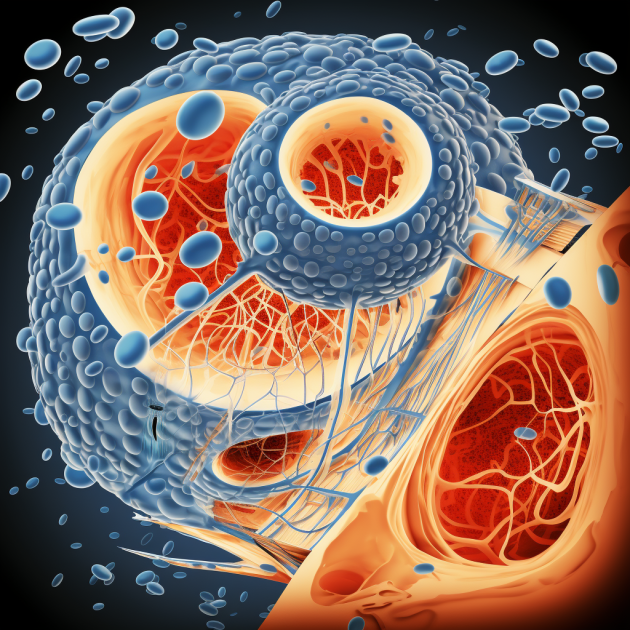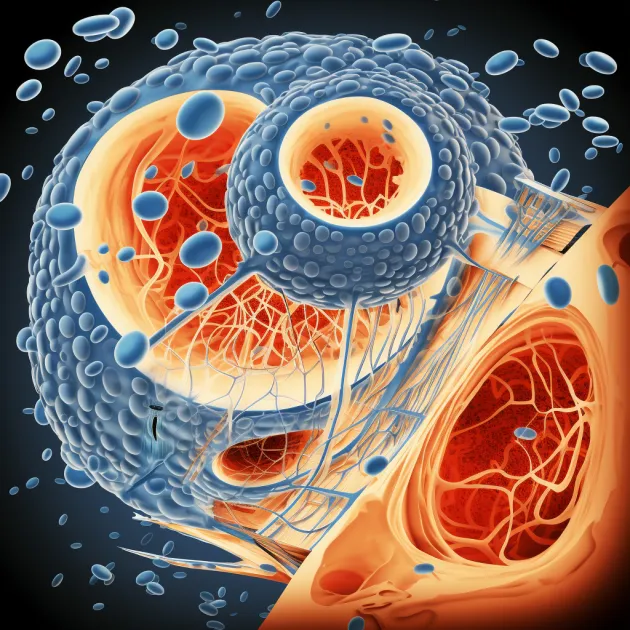Abstract:
Diabetes mellitus, a pervasive metabolic disorder, casts a long shadow over global health, its prevalence steadily on the rise. Amid the myriad of complications it spawns, two, in particular, loom large on the horizon: diabetic nephropathy (DN) and diabetic retinopathy (DR). These microvascular complications exact a heavy toll on affected individuals, both in terms of health and quality of life. Yet, the complex interplay between these two conditions has remained a riddle, defying straightforward explanation.
Recent scientific endeavors have endeavored to unravel the intricate web of molecular and cellular connections that might underlie the co-occurrence of DN and DR. This article serves as a portal into a groundbreaking study, where the power of single-cell RNA sequencing (scRNA-seq) was harnessed to peer into the secrets of renal mesangial cells (MCs) and retinal pericytes (RPCs). These seemingly disparate cell types, residing in distinct anatomical realms, have emerged as key players in the narrative of DN and DR.
As we embark on this journey through scientific discovery, we will navigate through the key findings of the study. These findings offer a glimpse into the shared molecular features that bind MCs and RPCs and potentially bridge the gap between DN and DR. However, our expedition goes beyond the realm of laboratory revelations. We shall explore the practical implications of these discoveries for clinical practice. Could the newfound insights pave the way for more precise diagnosis and prognosis of DN and DR? Are we on the verge of unearthing novel therapeutic strategies that may alleviate the burden of these microvascular complications for millions?
Join us as we delve into the depths of this research, illuminating the path toward a deeper understanding of the intricate relationship between DN and DR. In the following pages, the pieces of this intricate puzzle will come together, shedding light on the mysteries that have long confounded both scientists and healthcare providers.
Introduction:
Diabetes mellitus, a chronic metabolic disorder characterized by elevated blood glucose levels, is a global health concern affecting millions of individuals worldwide. Among its various complications, diabetic nephropathy (DN) and diabetic retinopathy (DR) stand as particularly formidable adversaries, posing significant health risks to those afflicted. While these complications manifest in distinct anatomical locations—the kidneys and the retina, respectively—it is not uncommon for them to co-occur in diabetic patients. This intriguing coexistence has long confounded researchers and clinicians alike, making it a subject of keen interest and extensive investigation.
The intricate relationship between DN and DR has remained elusive, with the mechanisms linking these two conditions shrouded in complexity. However, recent scientific endeavors have illuminated potential molecular and cellular connections that may bridge the knowledge gap surrounding these complications. This article embarks on a journey through a groundbreaking study that harnessed the power of single-cell RNA sequencing (scRNA-seq) to unveil shared molecular features between two seemingly unrelated cell types: renal mesangial cells (MCs) and retinal pericytes (RPCs). This discovery promises to usher in a fresh perspective on the intricate interplay between DN and DR, opening new doors to understanding and potentially treating these debilitating complications of diabetes.
As we delve into the depths of this pioneering research, we will not only explore the key findings that have emerged but also ponder the broader implications for clinical practice. Could the newfound insights into shared molecular features offer a path towards more accurate diagnosis and prognosis of DN and DR? Furthermore, might these discoveries present innovative therapeutic avenues, offering hope to the countless individuals who grapple with the burdensome consequences of diabetes-related microvascular complications? In the pages that follow, we shall unravel the mysteries surrounding the relationship between DN and DR, guided by the light of cutting-edge scientific inquiry.
Shared Molecular Features:
The study’s primary revelation is the remarkable similarity between MCs and RPCs, two seemingly disparate cell types. This discovery has far-reaching implications for our understanding of the relationship between diabetic nephropathy (DN) and diabetic retinopathy (DR). Under both physiological and diabetic conditions, these cells shared a high degree of transcriptional similarity, transcending the boundaries of their respective anatomical niches.
At first glance, MCs, found in the kidney’s glomeruli, and RPCs, residing in the delicate vascular network of the retina, appear unrelated in terms of function and location. However, the study’s findings challenge this conventional wisdom. The shared molecular profile observed in both MCs and RPCs suggests that they may be more closely related than previously thought.
Under physiological conditions, MCs and RPCs expressed similar molecular markers, particularly genes related to the composition of the extracellular matrix (ECM). This shared molecular signature is crucial for the stability and integrity of these cells in their respective environments. It implies that there might be a common underlying regulatory mechanism that governs these molecular features in both cell types, despite their different anatomical locations and functions.
The revelation of this shared molecular foundation raises intriguing questions about the evolutionary and developmental origins of these cells. Are there common ancestral pathways that led to the emergence of MCs and RPCs with such striking transcriptional similarities? Further investigations into the genetic and developmental aspects of these cell types could provide valuable insights into their shared ancestry.
The implications of this shared molecular profile extend beyond basic science. In the context of diabetes, this discovery takes on added significance. When exposed to diabetic conditions, both MCs and RPCs exhibited molecular transitions that are of particular interest. They upregulated genes related to chemotaxis, including several chemokines such as CXCL1, CXCL2, CXCL3, CXCL5, CXCL6, and CXCL8. These chemokines are known to be involved in inflammation and immune cell recruitment.
This upregulation of chemokines under diabetic conditions hints at a potential link between inflammation and the co-occurrence of DN and DR. It raises the question of whether a shared inflammatory response in MCs and RPCs could contribute to the development and progression of both conditions. Understanding this connection could have profound clinical implications, as it may open new avenues for therapeutic interventions targeting inflammation to manage and prevent DN and DR.
Chemokine Signaling Pathway Shedding Light on Diabetic Nephropathy:
One of the study’s pivotal findings was the upregulation of genes related to the chemokine signaling pathway in both renal mesangial cells (MCs) and retinal pericytes (RPCs) under diabetic conditions. This discovery sheds light on the intricate molecular processes that may contribute to the development and progression of diabetic nephropathy (DN) and diabetic retinopathy (DR).
Chemokines are a group of small proteins that play a crucial role in the immune system and inflammation. They act as signaling molecules, guiding immune cells to specific locations within the body in response to various stimuli, including infection, injury, or inflammation. The chemokine signaling pathway is responsible for regulating the movement and migration of immune cells in and out of tissues.
In the context of diabetes, the upregulation of genes related to chemokines such as CXCL1, CXCL2, CXCL3, CXCL5, CXCL6, and CXCL8 is of particular significance. These chemokines are known for their involvement in inflammation and immune cell recruitment.
- CXCL1 (GROα): CXCL1 is a chemokine that is involved in the recruitment of neutrophils, a type of white blood cell. Neutrophils play a crucial role in the initial response to infection and inflammation. In the diabetic context, the upregulation of CXCL1 suggests an increased recruitment of neutrophils, potentially contributing to the inflammatory response seen in DN and DR.
- CXCL2 (GROβ): CXCL2, like CXCL1, is involved in the recruitment of neutrophils. It amplifies the immune response by attracting additional neutrophils to the site of inflammation. In diabetic conditions, the upregulation of CXCL2 may further enhance the inflammatory processes in MCs and RPCs.
- CXCL3 (GROγ): CXCL3 is another chemokine that plays a role in neutrophil recruitment. Its upregulation in MCs and RPCs under diabetic conditions suggests a heightened inflammatory state in both the kidney and retina.
- CXCL5 (ENA-78): CXCL5 is involved in the recruitment of neutrophils and has been associated with various inflammatory diseases. Its upregulation in both MCs and RPCs implies a shared inflammatory response in the context of DN and DR.
- CXCL6 (GCP-2): CXCL6 is a chemokine that promotes the migration of neutrophils and other immune cells to sites of inflammation. Its increased expression in MCs and RPCs indicates a potential link between immune cell recruitment and the complications of diabetes.
- CXCL8 (IL-8): CXCL8 is a well-known chemokine that attracts neutrophils and other immune cells to areas of inflammation. Its upregulation in both MCs and RPCs suggests a common inflammatory pathway in DN and DR.
Importantly, the study found that the expression of these chemokines was significantly higher in DN patients complicated with DR compared to those without DR or healthy controls. This observation reinforces the potential link between chemokines and the co-occurrence of DN and DR.
The upregulation of these chemokines in MCs and RPCs under diabetic conditions highlights the role of inflammation in the development and progression of DN and DR. It suggests that targeting the chemokine signaling pathway may be a promising therapeutic approach to mitigate the inflammatory processes associated with these complications of diabetes. Further research into the precise mechanisms by which these chemokines contribute to DN and DR is warranted and may ultimately lead to more effective treatment strategies.
Chemokine Scores:
The concept of “chemokine scores” introduced in this study represents a novel and significant development in understanding the molecular intricacies of diabetic nephropathy (DN) and its co-occurrence with diabetic retinopathy (DR). These scores, calculated based on the expression of chemokine genes within specific cell types, offer valuable insights into the clinical relevance of the findings. Here, we delve deeper into the concept of chemokine scores without the use of headings:

Chemokine scores are quantitative measures that encapsulate the expression levels of chemokine genes, including notable ones like CXCL1, CXCL2, CXCL3, CXCL5, CXCL6, and CXCL8, within renal mesangial cells (MCs) and retinal pericytes (RPCs). These scores serve as a direct reflection of the extent to which these chemokines are upregulated or expressed under diabetic conditions.
What makes chemokine scores particularly intriguing is their ability to discriminate between DN patients with DR and those without DR. The study observed significant differences in these scores, indicating that the presence or absence of DR as a complication of DN is associated with distinct patterns of chemokine gene expression within MCs and RPCs.
From a clinical perspective, chemokine scores hold great promise. They can be regarded as potential biomarkers, which are measurable indicators that carry critical diagnostic and prognostic implications. Specifically:
- Diagnostic Potential: Chemokine scores can aid in the early and precise diagnosis of DN patients at risk of developing DR. This differentiation is crucial as it guides healthcare providers in tailoring treatment strategies to address the specific complications presented by each patient.
- Prognostic Value: These scores may offer insights into the likely progression and severity of DR in DN patients. Higher chemokine scores could indicate a greater risk of more severe complications, prompting more vigilant monitoring and therapeutic interventions.
- Treatment Implications: By identifying patients with elevated chemokine scores, healthcare professionals can consider more targeted treatment approaches. Therapies aimed at mitigating inflammation and modulating immune responses, associated with increased chemokine expression, may be warranted for these individuals.
- Monitoring and Personalized Medicine: Chemokine scores can facilitate personalized medicine by enabling regular monitoring of disease progression. Providers can adjust treatment plans based on changes in these scores over time, ensuring individualized and optimized care.
While the study has laid a foundation for the potential clinical utility of chemokine scores, it’s essential to acknowledge the need for further research and validation. Large-scale clinical studies are required to confirm the reliability and accuracy of these scores as robust biomarkers for DN and DR.
Chemokine scores represent a promising avenue for enhancing the diagnosis, prognosis, and treatment of diabetic nephropathy and its concurrent diabetic retinopathy. These scores offer a quantitative glimpse into the molecular underpinnings of these complications, opening doors to more precise and tailored healthcare interventions for affected individuals.
Clinical Implications:
The clinical implications of the study’s findings regarding chemokines and their role in diabetic nephropathy (DN) and diabetic retinopathy (DR) are substantial and far-reaching. These implications span diagnostic, prognostic, and therapeutic aspects of managing these challenging microvascular complications of diabetes.
- Early Diagnosis and Risk Assessment:
One of the most notable clinical implications is the potential for monitoring chemokine levels as a means of early diagnosis and risk assessment. Elevated chemokine expression, especially the key chemokines like CXCL1, CXCL2, CXCL3, CXCL5, CXCL6, and CXCL8, appears to be associated with the co-occurrence of DN and DR. This suggests that healthcare professionals can use chemokine levels as biomarkers to identify high-risk patients who may be at an increased likelihood of developing these complications.
Early diagnosis is crucial because it allows for timely intervention and management. By identifying individuals with heightened chemokine levels, healthcare providers can initiate more frequent monitoring and tailor their treatment plans accordingly. This proactive approach can potentially delay or mitigate the onset and progression of DN and DR, improving overall patient outcomes.
- Prognostic Value:
Beyond early diagnosis, chemokine levels may also have prognostic value. Patients with higher chemokine scores may be at greater risk of experiencing more severe complications or rapid disease progression. This prognostic information can guide healthcare providers in allocating resources and interventions to those who need them most urgently.
- Therapeutic Targets:
The study’s identification of chemokines as key players in the pathophysiology of DN and DR opens up new possibilities for targeted therapies. Chemokines are involved in inflammatory responses and immune cell recruitment, both of which play critical roles in the progression of these complications. As a result, modulating chemokine activity or developing therapeutics that target specific chemokines could be a viable strategy for managing DN and DR.
This finding underscores the importance of personalized medicine. Patients with elevated chemokine levels may benefit from therapies aimed at reducing inflammation and immune cell infiltration. Developing drugs or interventions that specifically target chemokines may provide more effective and precise treatments, potentially reducing side effects associated with broader immunosuppressive therapies.
- Monitoring and Treatment Personalization:
Chemokine levels can serve as dynamic indicators for disease activity. Regular monitoring of these levels can help healthcare providers track disease progression and response to treatment. This real-time feedback allows for treatment plans to be adjusted and personalized based on the patient’s evolving condition. It supports the concept of precision medicine, where interventions are tailored to the individual’s specific needs and response to therapy.
The study’s findings regarding chemokines offer a multifaceted approach to improving the clinical management of diabetic nephropathy and diabetic retinopathy. From early diagnosis to personalized treatment strategies, the role of chemokines in these complications holds great promise for enhancing patient care and outcomes. However, further research and clinical validation are essential to fully harness the clinical potential of these discoveries and translate them into practical healthcare applications.
Conclusion:
In summary, the groundbreaking study utilizing single-cell RNA sequencing (scRNA-seq) has not only provided a deeper understanding of the intricate relationship between diabetic nephropathy (DN) and diabetic retinopathy (DR) but has also introduced innovative concepts with significant clinical implications.
The revelation of shared transcriptional features between renal mesangial cells (MCs) and retinal pericytes (RPCs) under both physiological and diabetic conditions challenges our previous understanding of these seemingly distinct cell types. This newfound cellular connection hints at a complex interplay between the kidney and retina that may underlie the co-occurrence of DN and DR in diabetic patients.
Moreover, the upregulation of chemokines, including CXCL1, CXCL2, CXCL3, CXCL5, CXCL6, and CXCL8, in MCs and RPCs under diabetic conditions is a pivotal discovery. These chemokines are known for their involvement in inflammation and immune cell recruitment, processes central to the pathogenesis of DN and DR. The study’s demonstration of significantly higher chemokine expression in DN patients complicated with DR highlights the potential of chemokines as key players in the development and progression of these complications.
The introduction of chemokine scores as a diagnostic tool offers a practical avenue for clinical application. These scores have the potential to revolutionize the early diagnosis and risk assessment of DN and DR, enabling healthcare professionals to identify high-risk individuals and intervene promptly. This proactive approach aligns with the principles of preventive medicine and could lead to better outcomes for patients living with diabetes.
As we look to the future, these findings open doors to more effective management and treatment strategies for DN and DR. The concept of personalized medicine, where interventions are tailored based on an individual’s chemokine profile, holds great promise. Targeted therapies aimed at modulating chemokine activity could lead to more precise and less invasive treatments, improving the quality of life for those affected by these complications.
However, it’s essential to acknowledge that while this study represents a significant leap forward, further research is needed to validate these findings in larger patient populations and across different stages of DN and DR. Additionally, the translation of these discoveries from the laboratory to clinical practice will require rigorous evaluation and validation to ensure their safety and effectiveness.
In conclusion, this study’s innovative approach has illuminated a previously unrecognized cellular and molecular link between DN and DR. The shared transcriptional features, the role of chemokines, and the introduction of chemokine scores as a diagnostic tool collectively represent a promising avenue for advancing the field of diabetes-related complications. As research in this field continues to evolve, we can anticipate more precise, personalized, and effective strategies for the management and treatment of DN and DR, ultimately improving the lives of countless individuals living with diabetes.
If you need more information on this article click on the following link. This link will provide more extensive information and elaborate on the topic.
Genomic.News is your ultimate source for curated news, articles, and updates on the fascinating world of genomics. Our platform brings together the latest scientific breakthroughs, research advancements, and industry developments in one centralized hub. Stay informed about the cutting-edge discoveries, transformative technologies, and ethical considerations driving the field of genomics. Explore the intersection of genetics and healthcare, agriculture, biotechnology, and beyond.





